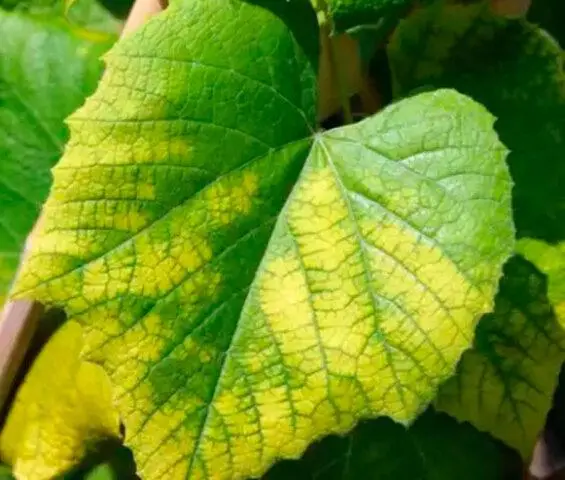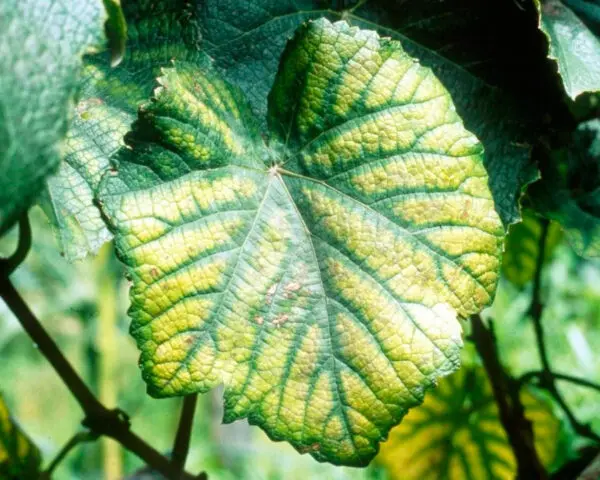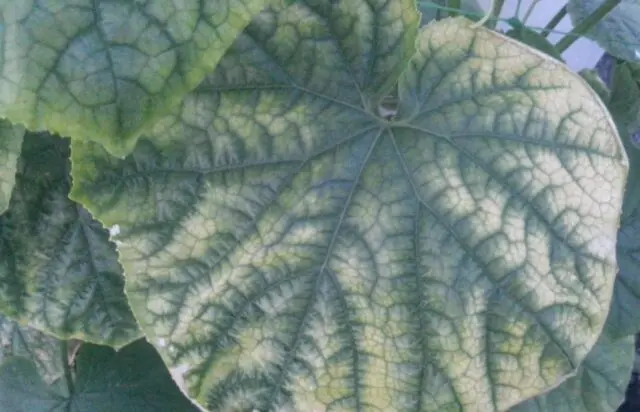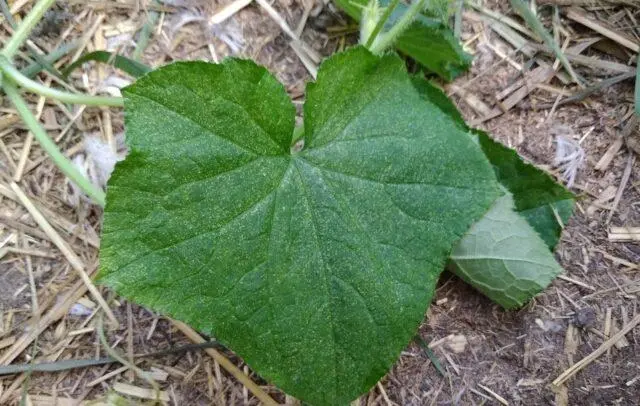Contents
Cucumber chlorosis is an infection that often affects this vegetable crop. It can harm not only young, but also already strong bushes growing both indoors and outdoors. There are quite a few reasons for the development of the disease, but the main ones are non-compliance with the rules for caring for cucumbers or a lack of any elements.
Description and photo chlorosis
Chlorosis infection is evidenced by yellowed leaves of the plant, which eventually begin to wither and fall off. If measures are not taken in time, cucumber bushes will die. The first sign of chlorosis is the appearance of yellow veins on the edges of the leaf blades. First, the leaves of cucumbers partially lose their color, begin to curl, new shoots become smaller, and the buds become deformed. Gradually, the disease progresses, the tops of the shoots weaken and dry, rotting serous areas appear on the plant. If left untreated, a moldy fungus occurs, due to which the roots of the culture rot. You can see in more detail the bushes of cucumbers suffering from chlorosis in the photo below.
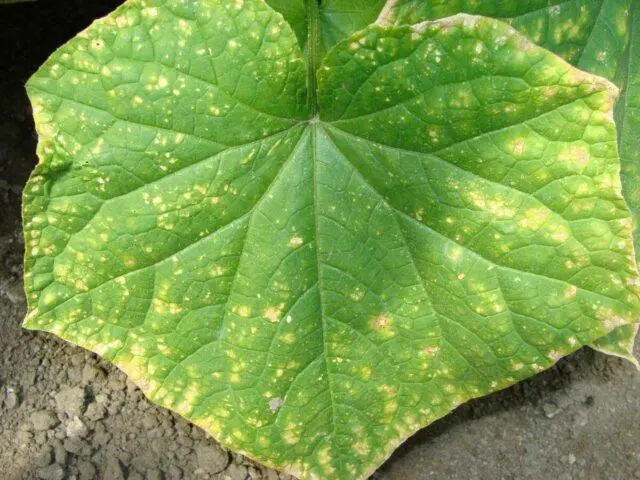
The disease spreads rapidly and can only be treated at the very beginning.
Types of disease
In nature, there are several types of chlorosis, each of them is dangerous in its own way and appears due to a number of reasons. There are the following types of the disease:
- Infectious. Spread by insects.

The infectious species is caused by pathogenic organisms, fungi, viruses
- Non-infectious. Often occurs due to adverse weather conditions.

A non-communicable disease can occur due to a lack of nutrients, errors in the care of cucumbers and when sowing them.
- Edaphic.

The edaphic type of the disease occurs when there are a lot of salts, lime in the soil, or during a period of heavy rainfall.
- Carbonate.

Carbonate chlorosis is caused by high levels of alkali in the soil.
Causes
The appearance of chlorosis on cucumbers can occur for various reasons, and, as many gardeners note, it is rather problematic to determine them. Usually they lie in the violation of the formation of chlorophyll and, therefore, with a low activity of photosynthesis. Often, chlorosis occurs due to a lack of substances necessary for the normal development of cucumbers. It can also cause culture poisoning.
Infectious chlorosis can begin due to possible infection from other plants or the transfer of spores of bacteria and fungi by insects. This type of disease is also called mosaic or spotting.
Non-infectious chlorosis manifests itself when there is a deficiency of iron, sulfur, zinc and other useful substances in the earth. It occurs quite often.
The development of chlorosis can occur for other reasons, for example:
- soil acidity – makes it difficult for the roots to absorb the necessary elements;
- dense planting of bushes, in connection with which the roots of cucumbers are crowded and they receive less oxygen;
- damage to the bushes at the time of picking or formation, reduces the immunity of the culture and increases its susceptibility to chlorosis;
- poor-quality soil drainage – provokes a large accumulation of water near the root system of the plant.
Less often, chlorosis can occur due to external factors: insufficient sunlight, drafts, improper organization of watering cucumbers, too high or low temperatures, high humidity.
Cucumbers grown in a greenhouse usually suffer from disease due to the special microclimate under cover and rarely changing soil.

In particular, the cause of chlorosis is an insufficient or excessive amount of trace elements in the soil.
How to treat chlorosis on cucumbers in a greenhouse
Since the disease responds well to treatment at the initial stage, it is important not to miss the moment of its appearance. But before starting treatment, it is desirable to identify the cause of the disease, and this is not always possible.
For cucumbers grown in greenhouses, ammonium sulfate cannot be used in the fight against chlorosis, since the earth is not washed out due to the film. In closed ground, vegetable crops are treated with ballast-free preparations.
The introduction of minerals
To eliminate chlorosis caused by a lack of trace elements, gardeners usually replenish them. To do this, use root or foliar top dressing of cucumbers.
In different situations, they resort to the use of certain drugs:
- with a lack of iron – Ferovit, Ferrilen, Micro-Fe, Chelate;
- due to the low content of calcium – wood ash, lime, egg shells;
- with a lack of sulfur – Kalimagnesia, Azofoska;
- due to magnesium deficiency – dolomite flour, Mag-Bor, magnesium sulfate;
- due to low levels of zinc – zinc oxide, superphosphate.
Agrecop or Ferrilen are used as universal remedies for combating cucumber chlorosis. But these drugs are suitable only at the very beginning of the disease. At the time of treatment, weather conditions and the extent of the lesion are taken into account. The procedure is carried out after seven o’clock in the evening or before ten in the morning in warm, calm weather.
To determine which substance is missing, you need to carefully examine the affected areas of the plant. Establish the cause of the disease, paying attention to the following features:
- If thin veins with interveinal areas between them are present on the leaf plates of cucumbers, young leaves first turn yellow or turn brown, then the plant is deficient in iron. And if the areas between the veins lighten, then the substance, on the contrary, is too much.
- When the veins themselves turn yellow, this is a signal that the cucumbers lack sulfur.
- If the veins on the lower leaves turn yellow or turn brown, then the culture needs nitrogen. And if the leaf plates begin to curl, there is too much substance.
- In the case of yellowing of the interveinal space of the old foliage of cucumbers and their pallor on the underside, magnesium supplementation is required. But if the greens darken, then the mineral in the soil contains more than necessary.
- If the leaf plates begin to rust along the edges, then manganese is required for cucumbers, and if brown spots appear on them, then its amount, on the contrary, is higher than normal.
- A signal of a lack of potassium is the manifestation of a brown color on greenery without initial yellowing, and the appearance of openwork patterns on the foliage of cucumbers indicates its excess.
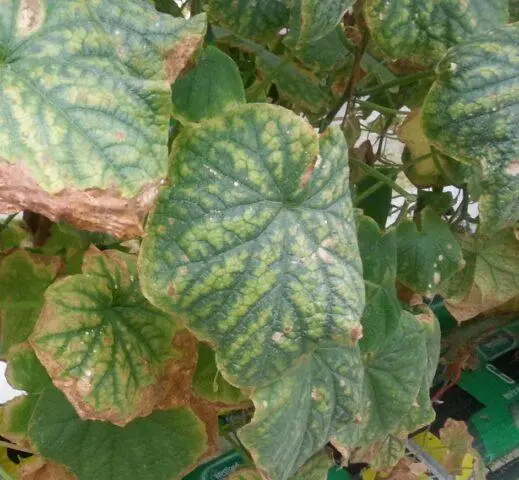
Dosed, prompt use of chemistry is the main opportunity to stop chlorosis
other methods
When chlorosis of cucumbers does not occur due to an imbalance of minerals, then their introduction into the soil will not be able to save the planting, and other ways to combat the disease come to the rescue:
- If the disease is caused by adverse conditions, for example, waterlogging, then watering is stopped, and drainage ditches are made in the beds. During frosts, cucumbers are fed. Plants shade when exposed to sunlight.
- If chlorosis began to progress due to an excess of minerals, then first of all they stop fertilizing the crop, and after that they try to restore the balance of elements.
- If pests have become the cause of the disease, cucumbers are sprayed with means to destroy them.
In addition, it is important to stop the spread of chlorosis. To do this, without fail, all damaged parts of the plant are cut off and carried away outside the greenhouse and garden. It is even better if the infected leaves and stems of cucumbers are burned.
preventive measures
Chlorosis is much more effective to prevent than to treat, therefore, prevention of the disease should be carried out: follow the technology of growing cucumbers, properly care for them, water them moderately. Allocate a plot for beds in a bright place, do not plant bushes at a small distance from each other. Fertilize the earth with organic matter and minerals in time. In the case when it is not clear what exactly is missing, it is better to use special mineral complexes for cucumbers, for example, Kemira Lux, Florist or Uniflor Micro.
Also, measures to prevent chlorosis include:
- inventory disinfection;
- disinfection of soil and planting material;
- pest control.
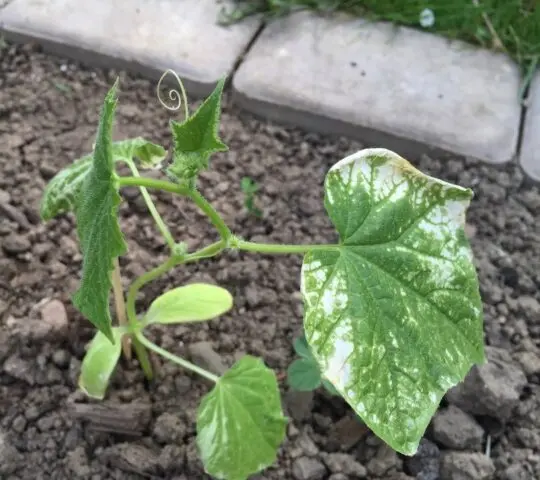
The most dangerous type of disease for cucumbers is infectious
Varieties resistant to chlorosis
Every year, breeders are trying to breed new varieties of cucumbers that are becoming more and more resistant to various diseases, including chlorosis. Currently, the best immunity is possessed by such hybrids as:
- early ripe varieties – Nightingale, Masha, Princess, Primadonna, Swallow, Boy-with-Finger;
- varieties of medium ripening – Zhuravlenok, Natalie, Murashka, Sudar, Pasadena, Benefis, Phoenix Plus, Octopus;
- late cucumbers – Leandro, Rodnichok, Golubchik.
These varieties of vegetable crops very rarely suffer from chlorosis. But if the recommended technologies are not observed when growing them, the disease will have every chance of appearing.
Conclusion
Cucumber chlorosis is an infectious disease of a culture that occurs when exposed to internal and external factors. To combat the problem, various chemical compositions are used, the choice of which depends on the type of disease. At the initial stage, the disease is easily treatable, but in a neglected situation, it is better to destroy the affected cucumber bushes than to allow it to spread.










